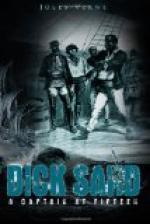The residence of the King of Kazounde, which borders on the business quarter, is a confused collection of ill-built hovels, which spread over the space of a mile square. Of these hovels, some are open, others are inclosed by a palisade of reeds, or bordered with a hedge of fig-trees. In one particular enclosure, surrounded by a fence of papyrus, thirty of these huts served us dwellings for the chief’s slaves, in another group lived his wives, and a “tembe,” still larger and higher, was half hidden in a plantation of cassada. Such was the residence of the King of Kazounde, a man of fifty—named Moini Loungga; and already almost deprived of the power of his predecessors. He had not four thousand of soldiers there, where the principal Portuguese traders could count twenty thousand, and he could no longer, as in former times, decree the sacrifice of twenty-five or thirty slaves a day.
This king was, besides, a prematurely-aged man, exhausted by debauch, crazed by strong drink, a ferocious maniac, mutilating his subjects, his officers or his ministers, as the whim seized him, cutting the nose and ears off some, and the foot or the hand from others. His own death, not unlooked for, would be received without regret.
A single man in all Kazounde might, perhaps, lose by the death of Moini Loungga. This was the contractor, Jose-Antonio Alvez, who agreed very well with the drunkard, whose authority was recognized by the whole province. If the accession of his first wife, Queen Moini, should be contested, the States of Moini Loungga might be invaded by a neighboring competitor, one of the kings of Oukonson. The latter, being younger and more active, had already seized some villages belonging to the Kazounde government. He had in his services another trader, a rival of Alvez Tipo-Tipo, a black Arab of a pure race, whom Cameron met at N’yangwe.
What was this Alvez, the real sovereign under the reign of an imbruted negro, whose vices he had developed and served?
Jose-Antonio Alvez, already advanced in years, was not, as one might suppose, a “msoungou,” that is to say, a man of the white race. There was nothing Portuguese about him but his name, borrowed, no doubt, for the needs of commerce. He was a real negro, well known among traders, and called Kenndele. He was born, in fact, at Donndo, or the borders of the Coanza. He had commenced by being simply the agent of the slave-brokers, and would have finished as a famous trader, that is to say, in the skin of an old knave, who called himself the most honest man in the world.
Cameron met this Alvez in the latter part of 1874, at Kilemmba, the capital of Kassonngo, chief of Ouroua. He guided Cameron with his caravan to his own establishment at Bihe, over a route of seven hundred miles. The convoy of slaves, on arriving at Kazounde, had been conducted to the large square.
It was the 26th of May. Dick Sand’s calculations were then verified. The journey had lasted thirty-eight days from the departure of the army encamped on the banks of the Coanza. Five weeks of the most fearful miseries that human beings could support.




